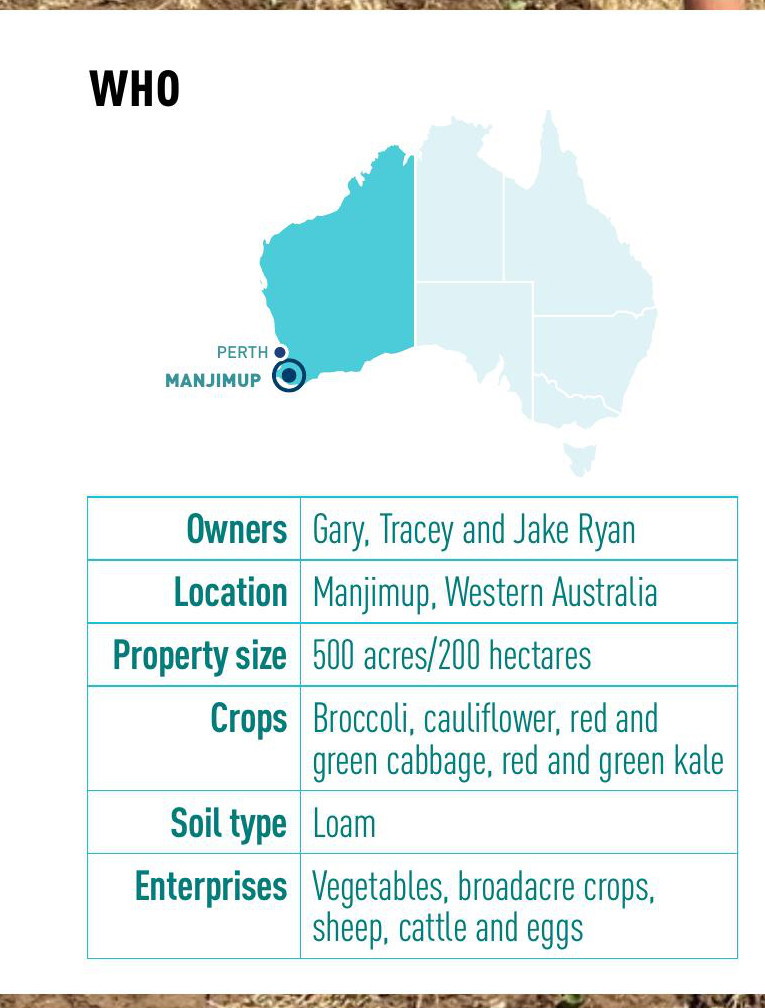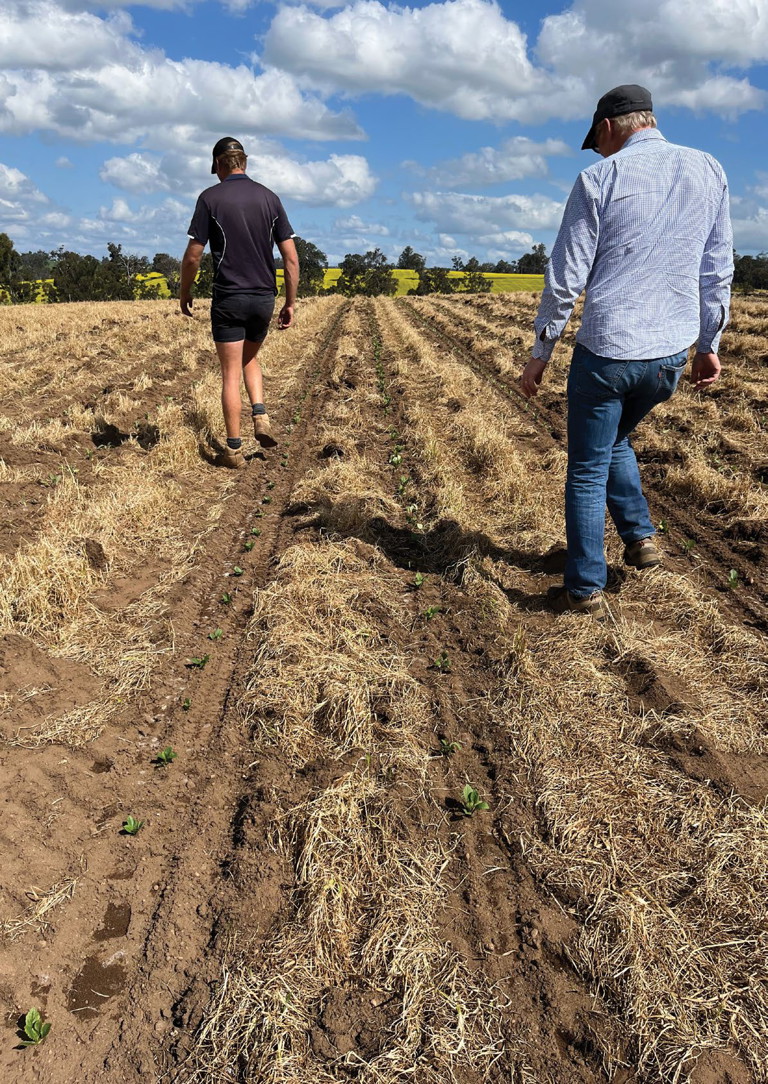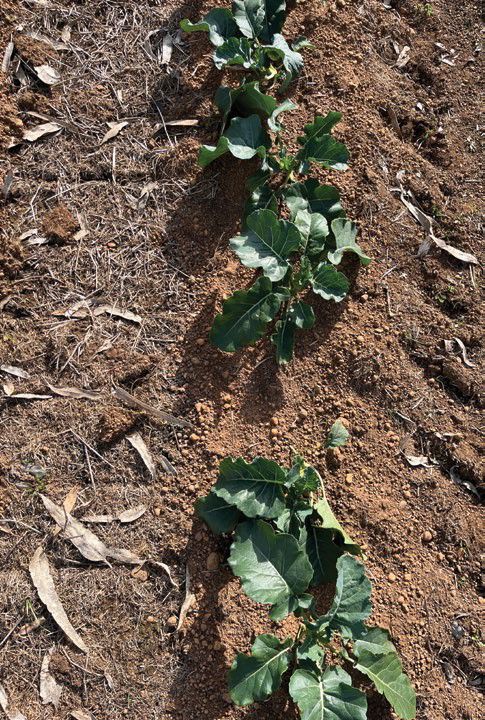
Casestudy
Cover
crops &
strip-till
The results are in – Soil Wealth reveals the findings of a soil health program at Three Ryans.

BY DIMI KYRIAKOU
RMCG



“ The strip-till machine paid itself off within the first year given the time and fuel we saved from reducing tillage. ”
WHAT THE SOIL Wealth and Integrated Crop Protection (ICP) project works with growers to put soil management and plant-health research into practice. We explore some of the key findings from the Three Ryans property (Manjimup, Western Australia) since embarking on a journey to improve soil health four years ago. Soil Wealth ICP Phase 2 (VG16078) is a strategic levy investment under the Hort Innovation Vegetable Fund.
Three Ryans first became involved with the Soil Wealth ICP project in 2019 with the goal of improving their soil health by trying cover cropping combined with strip-tillage. The Ryans hosted a demonstration site in 2019 showing their early activities as they tried new approaches to soil management. More details and the results of this demonstration can be found in the Benefits of a cover crop and striptill combination case study (www. soilwealth.com. au/resources/ case-studies/benefits-of-a-cover-cropstrip-till-combination). Fast forward three years and, despite some hurdles along the way, the Ryans have adopted the use of cover crops and strip-till more permanently in their operations.
“The strip-till machine paid itself off within the first year given the time and fuel we saved from reducing tillage,” Jake says. “The changes we have made have been beneficial not only to the success of our vegetable crops, but also to the health of our livestock.”
“ Importantly, the Ryans’ adoption of cover cropping and strip-tillage has helped create a favourable environment for arbuscular mycorrhizal fungi (AMF) to thrive. ”
The whole farm system approach
The Ryans’ farming system incorporates cover crops that also serve as pastures for livestock grazing. The rotation involves four years of cover crop/pasture then one year of vegetables, an important diseasemanagement strategy to give a lengthy break between brassica vegetable crops. A shift in focus to the whole farm system means each rotation complements the next, working like a well-oiled machine.
The cover crop has four years to establish before the ground is converted to vegetable production. In this time, the soil rests, allowing soil biology to thrive and organic matter levels to build. This, coupled with the diversity of plant species in the pasture rotation, builds good soil structure abundant with healthy roots.
Importantly, the Ryans’ adoption of cover cropping and strip-tillage has helped create a favourable environment for arbuscular mycorrhizal fungi (AMF) to thrive. AMF are beneficial fungi that occur naturally in the soil and develop symbiotic relationships with plants. The plant provides food for the fungi (photosynthates) in exchange for the fungi acting as an extension of the plant’s root system, which is useful for the uptake of water and immobile nutrients like phosphorus from the soil.
Soil samples collected from the Ryans’ mixed species cover crop returned high levels of AMF DNA, at 147 kDNA per gram of soil. Root samples from the clover and ryegrass species in the cover crop also returned a high colonisation rate of the plant roots of 60% by the fungi (Figure 1). Typically, colonisation is considered successful at levels greater than 10%. This is a positive sign that the Ryans’ farming system has created an environment that is highly favourable for AMF to thrive.
Choosing the right cover crop
The choice of cover crop, and timing of planting and termination, will be different for each grower. When deciding on a cover crop, decisions will be influenced by:
• What the grower would like the cover crop to achieve
• The whole farming system — Enterprises – livestock, vegetables
— What vegetable crops are being grown
— Rotations
• Window of time available to plant a cover crop
• Machinery available for planting and termination of cover crop
• Labour and time available to manage the cover crop
• Soil-borne diseases present at the site – choose non-hosts
• Soil type
• Location – region, topography
• Tolerance of residues in cash crop

FIGURE 1. ARBUSCULAR MYCORRHIZAL FUNGAL STRUCTURES (ARBUSCULES AND HYPHAE) DEMONSTRATING COLONISATION OF PLANT ROOTS.
The Ryans choose to sow diverse plant species in their cover crop to meet the dietary needs of their livestock. In the first year of their four-year cycle, perennial species are sown, then annual species are sown in the following three years. The perennial species cover crop is typically a mixture of plantain, chicory, perennial ryegrass, cocksfoot, phalaris, red clover, white clover and lucerne.

“ We treat our pastures as cover crops and have found that if we provide the right nutrients to the cover crops, we will see a positive flow on effect in our vegetable crops. ”
PASTURE cover crop containing a mix of annual species.

STRIP-TILL machine implements from R–L – straight depth coulter (cuts residue and maintains even depth), row cleaner (removes residue from strip), ripper shank (loosens soil), wavy coulter (controls tillage depth and width of strip) and rolling basket (breaks clods and smooths surface).
The annual species include a mixture of annual ryegrass, crimson clover, arrow clover, subterranean clover, balansa clover, medic, oats, ryecorn and barley. The Ryans avoid including brassica species in their cover crops to ensure there are no pest and disease host species in the years between their commercial brassica crops.
If the window between cash crops or rotations is short (eg, two months), growers should consider growing fewer species in their cover crop to save money. Some growers also grew their own cover crop seed each year to save costs.
Managing the cover crop
It is important for growers to consider management strategies for seeding rates, nutrient requirements and water availability to obtain best results from their cover crop. “We treat our pastures as cover crops and have found that if we provide the right nutrients to the cover crop, we will see a positive flow on effect in our vegetable crops,” says Jake.
Transitioning from cover crop to vegetable crop
The benefits obtained from the cover crop may be undone through excessive tillage when preparing for the vegetable crop. Strip-tillage helps to retain many of the soil health benefits, such as soil structure, soil biology and water retention that the cover crop has built because it causes less disturbance.
The Ryans typically terminate their cover crop with the herbicide Basta. If the transition occurs during winter and spring, the herbicide-treated area is left to take effect for four to six weeks before strip-tilling. If the transition occurs in the summer months, the cover crop is cut for silage to remove the biomass, because low soil moisture levels limit the breakdown of plant residues.
Once the plant residue is at a manageable level for the strip-till machine, striptillage is then undertaken ahead of transplanting the brassica seedlings.
Obtaining the best results – the Ryans’ key learnings
Depending on the farm system, most cover crops are grown for two to six months between cash crops. Longer term (eight months to multi-year) cover crops require the grower to be well organised and undertake careful planning when it comes to transitioning from the cover crop to the cash crop. Some considerations include:
• Timing of planting of the cover crop
• Growing period of the cover crop
• Timing of termination of the cover crop before preparing for vegetables
• Choice of cover crop species
The Ryans have fine-tuned the management of their system, but have experienced some challenges along the way. With the cover crop in place for four years, the plants had time to develop advanced root systems. This caused two issues for the Ryans:
#1 issue
The heavy biomass of the cover crop wrapped around the boot of the transplanter, disrupting planting of the seedlings, causing them to sit on the soil surface.
Solution
The Ryans added a straight disk in front of the boot on the transplanter to cut a line through the biomass. While it has been mostly effective during winter and spring, issues with biomass interfering with transplanting still occur in summer, due to slow residue breakdown. The Ryans are continuing to tweak their machinery and operations to identify a more consistent solution to managing residue levels.
#2 issue
The strip-till machine also struggled to cut through the cover crop biomass effectively, so root material was left bunched up on the surface of the soil also disrupting planting of the seedlings.
Solution
The Ryans allowed extra time (about four to six weeks during winter and spring) after the application of the herbicide used to terminate the cover crop to allow for the biomass to break down.
Both issues influenced the efficacy of transplanting, which led to slow early growth and variability in the establishment of the transplants. The uniqueness of the Ryans’ whole farming system, which involves their cover crop serving as longer-term pastures is relatively uncommon for most vegetable cropping systems. With the timing and mechanical changes implemented, the issues have been resolved through the spring months, but continue to be a work in progress during summer.
Thank you, Ryans
The Soil Wealth ICP team acknowledge the time and contributions of Gary, Tracey and Jake Ryan to the demonstration site in 2019 and subsequent activities associated with the Soil Wealth ICP project. The project was funded by Hort Innovation using the vegetable research and development levy and contributions from the Australian Government.
MORE INFORMATION
Visit soilwealth.com.au/resources/casestudies/ to read additional demonstration site case studies from the project in Victoria and New South Wales. Or contact project leaders Dr Gordon Rogers on (02) 8627 1040 gordon@ahr.com.au and Dr Anne-Maree Boland on (03) 9882 2670 or anne-mareeb@rmcg.com.au.
What we learned
Key benefits of cover crops and strip-tillage observed by the Three Ryans team.
• Reduced labour costs – reduction in number of passes from 10 to four, saving 10 hours per week during the vegetable-growing season
• Reduced cost of fuel – 10,000L saved in the first year
• Improved crop health and produce quality
• Improved soil structure
• Improved soil drainage
• Improved soil biology – including three times more earthworms than previously found
• Improved working conditions – inter row zone is less muddy
• Maintained yields
• Enhanced water retention through plant residue on soil surface
• Reduced erosion
• Reduced delays in field operations following heavy rainfall – possible to plant and harvest earlier than other growers in the region
• Reduced weed pressure


This project has been funded by Hort Innovation using the vegetable research and development levy and funds from the Australian Government. For more information on the fund and strategic levy investment visit horticulture.com.au
Project Number: VG16078